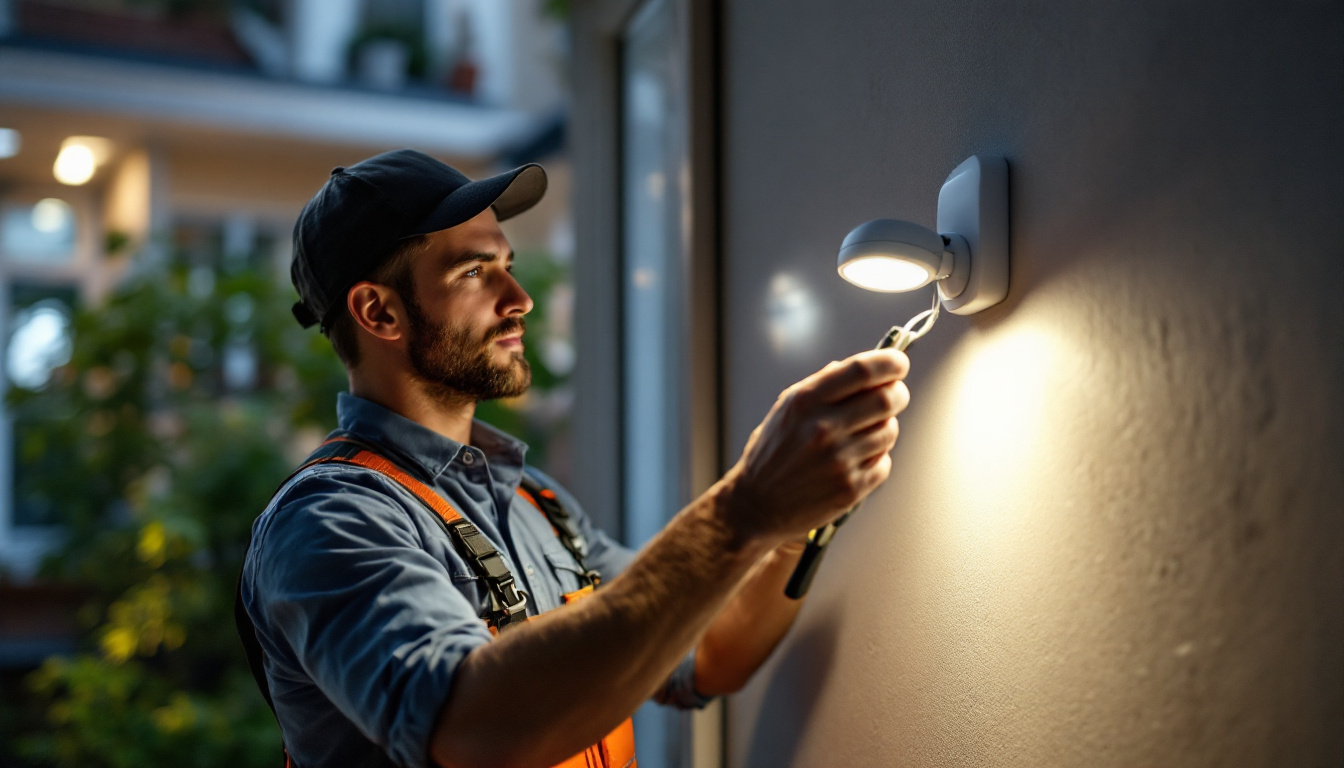
LED lighting has transformed the way professionals approach illumination projects. Its efficiency, longevity, and versatility make it the preferred choice across residential, commercial, and industrial sectors. But to leverage LED technology effectively, contractors must grasp its core principles and nuances.
At its essence, LED (Light Emitting Diode) technology produces light through electroluminescence. Unlike traditional incandescent or fluorescent bulbs, LEDs emit light in a specific direction, reducing wasted energy. This directional lighting not only enhances efficiency but also allows for more precise lighting designs. The compact size of LEDs also means they can be integrated into a variety of fixtures and applications that were previously not feasible with larger bulbs, opening up new possibilities for creative lighting solutions.
Another critical factor is the color temperature of LEDs, measured in Kelvins (K). LEDs can range from warm white (2700K) to daylight (6500K) and beyond, enabling contractors to tailor lighting atmospheres to client needs. Understanding how color temperature influences mood and productivity is essential when specifying LED products. For instance, warmer tones are often preferred in residential settings to create a cozy ambiance, while cooler tones are more suitable for workspaces, as they can enhance alertness and focus. Additionally, the ability to dim LEDs or adjust their color temperature dynamically can further enhance their versatility, allowing for adaptable lighting solutions that can change throughout the day or for different activities.
One of the biggest selling points of LED lighting is its energy efficiency. LEDs consume up to 75% less energy than incandescent bulbs and last 25 times longer. For contractors, this translates into significant value propositions for clients—lower utility bills and reduced maintenance costs. The longevity of LEDs also means fewer replacements, which is particularly beneficial in hard-to-reach fixtures or high-traffic areas where changing bulbs can be disruptive and costly.
When planning installations, consider the total cost of ownership rather than just upfront expenses. Though LEDs may carry a higher initial price tag, their durability and efficiency often result in a lower lifetime cost. Presenting these figures clearly can help clients make informed decisions. Furthermore, many regions offer incentives or rebates for energy-efficient upgrades, which can offset initial costs and make LED installations even more appealing. Contractors should stay informed about local programs to provide clients with comprehensive financial assessments and potential savings.
Lighting contractors should be familiar with various LED types to select the right product for each project. Some common forms include:
Knowing the strengths and limitations of each type ensures optimal performance and client satisfaction. Additionally, contractors should be aware of emerging LED technologies, such as smart LEDs that can be controlled via mobile applications or integrated with building management systems. These innovations not only enhance user convenience but also contribute to energy savings and improved operational efficiency. As the industry evolves, staying updated on the latest advancements will empower contractors to offer cutting-edge solutions that meet the diverse needs of their clients.
Design is where a lighting contractor’s expertise truly shines. LED systems offer unparalleled flexibility, but this can also complicate the design process. Successful projects balance aesthetics, functionality, and energy efficiency. The integration of LED technology not only enhances the visual appeal of spaces but also promotes sustainability, making it a crucial consideration in modern design.
Before selecting fixtures or layouts, conduct a thorough assessment of the space. Consider ceiling height, natural light availability, room function, and client preferences. For example, a retail store may require bright, uniform lighting to highlight products, whereas a restaurant might benefit from warmer, dimmable LEDs to create ambiance. Additionally, understanding the demographic of the space’s users can further refine the lighting design; for instance, a children’s play area might need softer, more playful lighting, while an office space may prioritize clarity and focus.
Engage clients in discussions about their goals. Are they looking to reduce energy costs, improve lighting quality, or create a specific atmosphere? Understanding these priorities guides the entire design process. It can also be beneficial to explore the emotional impact of lighting, as different color temperatures and intensities can evoke various feelings and responses, influencing how people interact with a space.
Effective LED lighting systems often employ a layered approach, combining three types of lighting:
Using these layers strategically enhances both the functionality and visual appeal of a space. LEDs excel in all three roles due to their adaptability and range of options. For instance, adjustable track lighting can serve as both task and accent lighting, allowing for flexibility in how spaces are utilized. Furthermore, the choice of fixtures—whether recessed, pendant, or wall-mounted—can significantly influence the overall aesthetic, making it essential to align these choices with the desired design narrative.
Dimming capabilities and smart controls are increasingly important in LED lighting systems. They allow users to adjust brightness based on time of day or activity, improving comfort and energy savings. Lighting contractors should be well-versed in compatible dimmers and control systems to ensure seamless integration. The rise of smart home technology has also opened up new avenues for control, enabling users to manage their lighting through mobile apps or voice commands, thus enhancing convenience and personalization.
Moreover, incorporating occupancy sensors and daylight harvesting controls can optimize energy use by automatically adjusting lighting when spaces are unoccupied or when natural light is sufficient. This not only contributes to lower energy bills but also aligns with green building practices, appealing to environmentally conscious clients. As technology continues to evolve, staying updated on the latest advancements in LED controls will empower lighting contractors to offer innovative solutions that meet the dynamic needs of their clients.
Proper installation is critical to maximize LED performance and longevity. Lighting contractors must follow industry standards and manufacturer guidelines closely.
Before installation, inspect existing wiring and fixtures. LEDs often require compatible drivers and power supplies. Ensure electrical systems can handle the load and that connections are secure. In some cases, upgrading wiring or panels may be necessary.
Safety is paramount. Always adhere to local electrical codes and wear appropriate protective gear. Planning the installation sequence can minimize disruptions, especially in occupied commercial or residential spaces.
LEDs are sensitive to heat and static electricity. Handle components carefully to avoid damage. Proper heat dissipation is vital; many LED fixtures include heat sinks to prevent overheating. Ensure that fixtures have adequate ventilation and are mounted according to specifications.
When installing LED strips, use suitable adhesives or mounting channels to secure them. Avoid bending strips sharply, which can damage internal circuitry.
After installation, thoroughly test all lighting circuits. Check for flickering, uneven brightness, or color inconsistencies. These issues can indicate wiring problems, incompatible dimmers, or defective components.
Document all tests and provide clients with information on operating their new lighting systems. Offering maintenance tips and warranty details can enhance client trust and satisfaction.
The LED lighting industry continues to evolve rapidly. Contractors who stay informed about the latest trends and technologies maintain a competitive edge.
Human-centric lighting focuses on adjusting color temperature and intensity to support natural circadian rhythms. This approach can improve wellbeing, productivity, and sleep quality. LEDs with tunable white capabilities allow dynamic changes throughout the day, making them ideal for offices, healthcare facilities, and schools.
Smart lighting integrates with building automation systems, enabling centralized control, scheduling, and energy monitoring. Voice-activated controls and smartphone apps offer convenience for end-users. Lighting contractors should familiarize themselves with protocols like Zigbee, Z-Wave, and Bluetooth Mesh to recommend compatible products.
LEDs are inherently more sustainable than traditional lighting, but new developments focus on further reducing environmental footprints. This includes using recyclable materials, improving energy efficiency beyond current standards, and minimizing hazardous substances.
Contractors can advise clients on certifications such as ENERGY STAR and DesignLights Consortium (DLC) listings to ensure products meet rigorous performance and sustainability criteria.
Beyond technical skills, successful lighting contractors excel at communication and service. Clients value clear explanations, realistic expectations, and post-installation support.
Take time to educate clients about LED benefits and limitations. Visual aids like mockups or lighting simulations can help clients visualize outcomes. Transparent discussions about costs, timelines, and maintenance foster trust.
Offering maintenance services, warranty assistance, and troubleshooting support can differentiate your business. Prompt responses to client inquiries and proactive follow-ups show commitment to quality and customer satisfaction.
Investing in ongoing education and certifications, such as those from the National Institute for Certification in Engineering Technologies (NICET) or the Illuminating Engineering Society (IES), enhances credibility. Staying current with evolving standards and technologies ensures your services remain top-tier.
LED lighting presents unparalleled opportunities for lighting contractors willing to deepen their expertise. Understanding the technology, mastering design principles, executing precise installations, and embracing innovation are keys to delivering exceptional results.
By combining technical knowledge with strong client relationships, contractors can build a reputation for excellence and secure a steady flow of projects. The future of lighting is bright, and those who adapt will illuminate it best.
Ready to elevate your lighting game? At LumenWholesale, we provide lighting contractors like you with the highest quality, spec-grade LED lighting products at unbeatable wholesale prices. Say goodbye to local distributor markups and hello to a vast selection of reliable, high-performance lighting that meets the most rigorous industry standards. With free shipping on bulk orders, you can stock up on premium lighting solutions without worrying about hidden fees or compromises. Don’t miss out on the perfect combination of quality, affordability, and convenience. Discover the value of wholesale lighting and take your projects to the next level with LumenWholesale.

Discover essential tips and best practices for lighting contractors on installing and maintaining ceiling light fan switches.

Discover the top strategies lighting contractors use for ceiling mount light fixtures.

Discover the essential checklist for lighting contractors focusing on sensor automatic lights.

Discover expert tips and insights on selecting and installing LED factory lights tailored for lighting contractors.